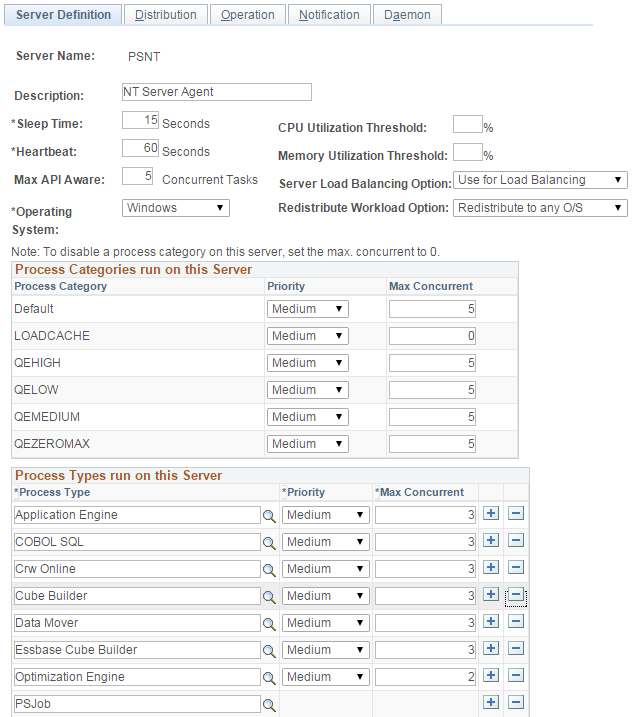Using the PSADMIN Utility to Configure Process Scheduler Tuxedo Servers
All of the PeopleSoft Process Scheduler server configuration information for a specific database is contained in the PSPRCS.CFG configuration file, and the PSADMIN utility provides an interface for editing the PSPRCS.CFG file.
This section discusses how to set parameters for the:
Distribution Agent (PSDSTSRV).
Application Engine Server (PSAESRV).
Master Scheduler Server (PSMSTPRCS).
The PeopleSoft system automatically archives the Process Scheduler configuration file whenever it is changed. The older version is archived as PSPRCS_<Time Stamp>.CFG and the current version becomes psprcs.cfg. The archive directory path is <PS_CFG_HOME>\Appserv\<database>\Archive\, for example, C:\Documents and Settings\admin\psft\pt\8.50\Appserv\fin50\Archive\
The Distribution Agent posts reports and system log files to the Report Repository. When the PSPRCSRV server detects that a process has finished, it sends the PostReport Oracle Tuxedo service request to the Distribution Agent to initiate the transfer of the report.
Parameter | Description |
|---|---|
Max Instances (maximum instances) |
Indicates the maximum number of Distribution Agents (PSDSTSRV) that can be started within Oracle Tuxedo. The default value is 2. |
Min Instances (minimum instances) |
Indicates the minimum number of Distribution Agents (PSDSTSRV) that can be started within Oracle Tuxedo. The default value is 1. |
Recycle Count |
Indicates the number of services after which PSDSTSRV automatically restarts. If this is set to 0 (default), PSDSTSRV is never recycled. |
Allowed Consec Service Failures (allowed consecutive service failures) | Indicates the number of consecutive service failures after which PSDSTSRV automatically restarts. If this is set to 0 (default), PSDSTSRV is never recycled. |
This server is responsible for running requests with a process type of Application Engine.
Parameter | Description |
|---|---|
Max Instances |
Indicates the maximum concurrency set for process types with a generic process type of Application Engine, as defined on the Server Definition page in Process Scheduler Manager. |
Recycle Count |
Indicates the number of services after which PSAESRV automatically restarts. If this is set to 0 (default), PSAESRV is never recycled. See Recycle Count. |
Allowed Consec Service Failures |
Indicates the number of consecutive service failures after which PSAESRV automatically restarts. Server processes must be intermittently recycled to clear buffer areas. If this is set to 0 (default), PSAESRV is never recycled. |
ScheduledQuery - DirtyRead | This parameter only applies to DB2. Indicates if dirty reads are enabled. Setting this to 1 enables the application server to read uncommitted data from a table. If this is set to 0 (default), dirty reads are disabled. |
PSAESRV Max Instance and Application Engine Max Concurrent
By default, three instances of the PSAESRV are booted in PeopleSoft Process Scheduler to allow the maximum concurrent processes, as specified in the server definition. If this server is intended to increase or decrease the maximum concurrent for PeopleSoft Application Engine, you must change Max Instances in the PSAESRV section of the process configuration file to match the Max Concurrent value for PeopleSoft Application Engine. PeopleSoft Process Scheduler schedules the maximum concurrent processes for PeopleSoft Application Engine based only on the minimum number from both values.
Note: Because PSAESRV runs both of the Application Engine and Optimization Engine processes, you must include the Max Concurrent for the Application Engine and Analytic Engine process type when you configure the number of PSAESRV tuxedo processes in the domain.
Select to access the Server Definition page.
Image: Server Definition page
This example illustrates the fields and controls on the Server Definition page.

PSAE Versus PSAESRV
You should use PSAESRV because it delivers improved system performance.
If PeopleSoft Process Scheduler was set to not start any instance of PSAESRV in Microsoft Windows or UNIX, but the server definition corresponding to this server allows you to run PeopleSoft Application Engine, then Process Scheduler initiates an Application Engine program using the $PS_HOME\bin\psae executable.
Note: This functionality is similar to how PeopleSoft Process Scheduler initiates PeopleSoft Application Engine in OS390.
Master Scheduler is an optional server that enables you to distribute workload across multiple Process Schedulers. However, in certain conditions, a Master Scheduler is required.
Note: You should always use a Master Scheduler.